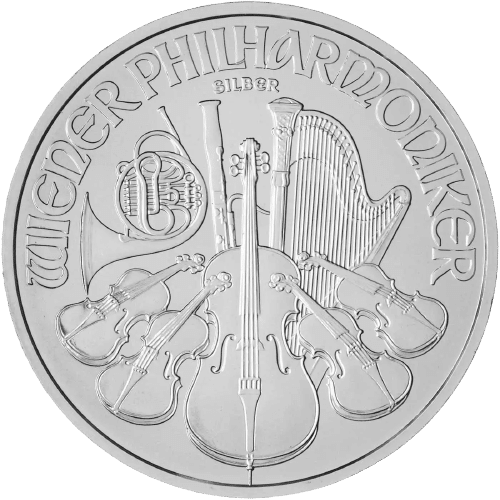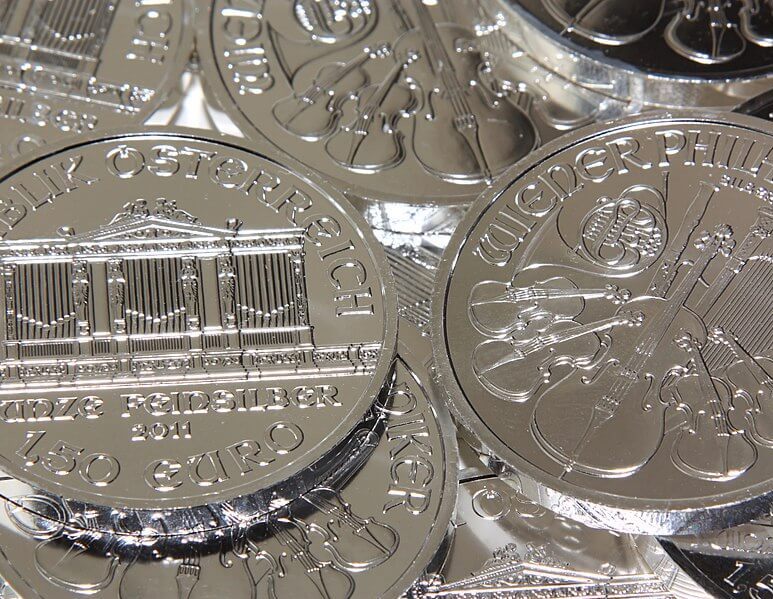The world-renowned Vienna Philharmonic was founded in 1842. As a way to pay tribute to the celebrated orchestra, Austria introduced the Austrian Philharmonic Coin series in 1989, with the first coin of the series being minted in gold.
The world-renowned Vienna Philharmonic was founded in 1842. As a way to pay tribute to the celebrated orchestra, Austria introduced the Austrian Philharmonic Coin series in 1989, with the first coin of the series being minted in gold.

In 2008, the Austrian Mint introduced the 1oz Austrian Philharmonic Silver coin, which has since become the most popular silver bullion coin produced in Europe, selling over 54 million in the first 5 years. Unlike its international silver coin series competitors, this coin is only made in a 1oz size. The Austrian Philharmonic Silver coin is also one of the only coins with a face value in Euros – 1.5 EUR, to be exact. Large coins have been made throughout the coin’s history, but those have only been reserved for limited editions. Due to its beautiful craftsmanship, the oz Austrian Philharmonic Silver coin is one of the most famous and sought-after silver coins in the world. The coin is 99.9% pure silver, with a diameter of 37mm, and a thickness of 3.2 mm.

Both sides of the 1oz Austrian Philharmonic Silver coin were designed by the Austrian Mint Chief Engraver, Thomas Pesendorfer, in 1989. The intricate details Pesendorfer incorporated into both sides of the coin make the coin not only a great investment but also a beautiful addition to any collection.
The 1oz Austrian Philharmonic Silver coin was minted to celebrate the Vienna Philharmonic Orchestra. Each coin minted in the series features an image of the Musikverein Golden Hall’s Great Organ engraved on the obverse. The organ is accompanied by inscriptions reading “Republik Osterreich,” German for “Republic of Austria,” and “1 Unze Feinsilber,” meaning “1 oz pure silver.” The reverse side of the coin series features an engraving of musical instruments like the cello, bassoon, violins, and horns. It also has inscriptions reading “Wiener Philharmoniker” and “Silber,” German for “Vienna Philharmonic” and “silver,” respectively.

Since the 1 oz Austrian Silver Philharmonic Coin isn’t produced in proof or uncirculated versions, the Austrian mint created two special versions of the coin – gilded and colorized.
The gilded version contains a layer of 24-karat gold on both sides of the coin. While this coating isn’t enough to change the coin’s value, it does add to the coin’s beauty, craftsmanship, and overall value.
The colorized version sports the reverse side’s instruments in muted colors. For example, the violins and cello are minted with muted wooden colors to display them as they are in real life.
It’s important to note that although these coins are aesthetically beautiful and add great value to a coin collection, these specialized versions are not IRA-approved.
If you’re still questioning if the Austrian Silver Philharmonic Coin is the right coin for you, we’ve included some of our client’s most asked questions. If you still have questions, don’t hesitate to give us a call.
At the time of writing, the spot price of silver is approximately $21, and the asking price of the Austrian Silver Philharmonic is approximately $30. The price will fluctuate according to the spot price of silver as well as the year of the coin.
The coin tube is a small, cheap product that allows investors to hold their 1oz Austrian Silver Philharmonic coins in one place. The tube holds 20 coins and protects them from scratches and oxidation. Its red cap includes the Austrian Mint seal.
Investors can either buy the coin tube separately or are able to purchase 20 coins and the tube together.
Being one of the largest mints in Europe, the Austrian Mint has gained a reputation for producing quality coins. When the 1 oz Philharmonic Silver coin was first minted in 2008, 7,773,000 units were released, and until 2013, the number of minted units never fell below that number. In fact, the coin recorded its peak production in 2011 when 17,873,700 units were produced. Suffice to say this consistently high supply of the coin can only mean that there is consistently high demand.
Another component that signifies this coin is a good investment is its ability to hedge against inflation and the stock market’s volatility. During any given day, investors can never be sure how well their paper investments will perform. But one thing is for sure, and that’s no matter if the stock market performs well or plummets, silver will continue to be in high demand.
This high demand comes not only from its use in jewelry, but the medical field has recently taken advantage of silver’s electrical conductivity to help fuel tools and other medical devices. During the big precious metal boom a couple of centuries ago, because silver wasn’t as popular as gold, it wasn’t purposefully mined for. The little supply that was mined is quickly dwindling, contributing to the supply and demand effect. The more different fields take advantage of silver, the less there will be on hand, ultimately increasing the price.